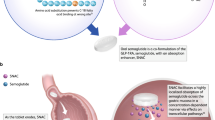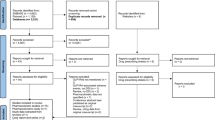Abstract
Objective
The primary aim of this study was to determine whether there is an effect of colesevelam HCl (WelChol®; Sankyo Pharma Inc., Parsippany, NJ, USA) on fenofibric acid (active metabolite of fenofibrate, TriCor®, Abbott Laboratories, North Chicago, IL, USA) pharmacokinetics following single-dose fenofibrate when colesevelam HCl and fenofibrate are administered concomitantly, or when colesevelam HCl is administered 4 hours following fenofibrate therapy.
Methods
Thirty healthy volunteers were enrolled in a randomised, open-label, three-way crossover, drug interaction study. Subjects received one of three treatments at each of three dose administration periods: (i) treatment A -fenofibrate 160mg plus colesevelam HCl 3750mg (6 × 625mg tablets) administered with breakfast; (ii) treatment B - fenofibrate 160mg administered with breakfast, followed 4 hours later by colesevelam HC1 3750mg (6 × 625mg tablets) administered with lunch; or (iii) treatment C - fenofibrate 160mg administered with breakfast. Treatments were separated by a 10-day washout period. Blood samples were collected at predetermined time intervals, both before and after drug administration. Plasma concentrations of fenofibrate and fenofibric acid were measured using a validated liquid chromatography/mass spectroscopy/mass spectroscopy method.
Results
Area under the concentration-time curve (AUC) from time zero to the timepoint of the lowest quantifiable concentration (AUCt), AUC from time zero to infinity (AUC∞) and maximum plasma concentration (Cmax) for fenofibric acid were 92.1%, 93.9% and 79.8%, respectively, of control values when colesevelam HC1 and fenofibrate were coadministered with breakfast; and 91.9%, 93.9% and 99.1%, respectively, when fenofibrate was administered followed 4 hours later by administration of colesevelam HC1. The 90% confidence intervals for the ratios of geometric means for AUCt, AUC∞ and Cmax comparing the three treatments were contained within the 80–125% equivalence range, with the exception of Cmax for treatment A. Coadministration of fenofibrate with colesevelam HCl resulted in an approximate 20% reduction in Cmax of the active metabolite (fenofibric acid). There were no significant differences in the time to Cmax, elimination rate constant or elimination half-life between any of the treatment groups.
Conclusions
Colesevelam HCl had no significant effect on fenofibrate bioavailability when administered either concomitantly with fenofibrate or 4 hours after fenofibrate.


Similar content being viewed by others
Notes
The use of trade names is for product identification purposes only and does not imply endorsement.
Coadministration of ezetimibe with fibrates is not recommended as the safety and effectiveness of this combination has not been established at this time.
References
NCEP-ATPIII. Third report of the National Cholesterol Education Program (NCEP) Expert Panel on Detection, Evaluation, and Treatment of High Blood Cholesterol in Adults (Adult Treatment Panel III): expert panel report. Bethesda (MD): National Heart, Lung, and Blood Institute; 2002 Sep. Report no.: NIH 02-5215
Xydakis AM, Ballantyne CM. Combination therapy for combined dyslipidemia. Am J Cardiol 2002; 90(10B): 21–29K
Pasternak RC, Smith SC, Bairey-Merz CN, et al. ACC/AHA/NHLBI clinical advisory on the use and safety of statins. Circulation 2002; 106: 1024–8
Shepherd J, Packard CJ, Bicker S, et al. Cholestyramine promotes receptor-mediated low-density-lipoprotein catabolism. N Engl J Med 1980; 302(22): 1219–22
Barbir M, Hunt BJ, Galloway D, et al. A randomized pilot trial of low-dose combination lipid-lowering therapy following coronary artery bypass grafting. Clin Cardiol 1994; 17(2): 59–64
Brown WV. Review of clinical studies of fenofibrate in combination with currently approved lipid-lowering drugs. Cardiology 1989; 76 Suppl. 1: 45–51
Malmendier CL, Delcroix C, Lontie JF. The effect of combined fenofibrate and cholestyramine therapy on low-density lipoprotein kinetics in familial hypercholesterolemia patients. Clin Chim Acta 1987; 162(2): 221–7
Weisweiler P. Low-dose colestipol plus fenofibrate: effects on plasma lipoproteins, lecithin, cholesterol acyltransferase, and postheparin lipases in familial hypercholesterolemia. Metabolism 1989; 38(3): 271–4
TriCor® fenofibrate tablets package insert. North Chicago (IL): Abbott Laboratories, 2001 Aug
Colestid® package insert. Kalamazoo (MI): Pharmacia & Upjohn Company, 2003
LoCHOLEST powder package insert. Rockaway (NJ): Warner Chilcott Laboratories, 1998 Mar
Brown WV. New therapies on the horizon. Am J Manag Care 2001; 7 Suppl. 5: S148–51
WelChol® (Colesevelam HC1) package insert v8. Parsippany (NJ): Sankyo Pharma Inc., 2003
Balmori Melian E, Plosker G. Colesevelam. Am J Cardiovasc Drugs 2001; 1(2): 141–6
Heller DP, Burke SK, Davidson DM, et al. Absorption of colesevelam hydrochloride in healthy volunteers. Ann Pharmacother 2002; 36(3): 398–403
Braunlin W, Zhorov E, Smisek D, et al. In vitro comparison of bile acid binding to colesevelam HC1 and other bile acid sequestrants. Polymer Preprints 2000; 41: 708–9
Davidson MH, Dillon MA, Gordon B, et al. Colesevelam hydrochloride (cholestagel): a new, potent bile acid sequestrant associated with a low incidence of gastrointestinal side effects. Arch Intern Med 1999; 159(16): 1893–900
Insull WJ, Toth P, Mullican W, et al. Effectiveness of colesevelam hydrochloride in decreasing LDL cholesterol in patients with primary hypercholesterolemia: a 24-week randomized controlled trial. Mayo Clin Proc 2001; 76(10): 971–82
Donovan JM, Stypinski D, Stiles MR, et al. Drug interactions with colesevelam hydrochloride, a novel, potent lipid-lowering agent. Cardiovasc Drugs Ther 2000; 14(6): 681–90
Metropolitan Life Insurance. 1983 Metropolitan height and weight tables. Stat Bull Metrop Life Found 1983; 64: 3–9
Rowland M, Tozer TN, editors. Clinical pharmacokinetics: concepts and applications. 3rd ed. Philadelphia (PA): Lippincott Williams & Wilkins, 1995
Data on file, Sankyo Pharma, Inc.
Bays HE, Dujovne CA. Drug interactions of lipid-altering drugs. Drug Saf 1998; 19(5): 355–71
Ascah KJ, Rock GA, Wells PS. Interaction between fenofibrate and warfarin. Ann Pharmacother 1998; 32(7–8): 765–8
Zetia® (ezetimibe) package insert. North Wales (PA): Merck/Schering-Plough Pharmaceuticals, 2004
Lopid® package insert. Vega Baja; Pfizer Pharmaceuticals Ltd, 2003
Malloy MJ, Ravis WR, Pennell AT, et al. Effect of cholestyramine resin on single dose valproate pharmacokinetics. Int J Clin Pharmacol Ther 1996; 34(5): 208–11
Hibbard DM, Peters JR, Hunninghake DB. Effects of cholestyramine and colestipol on the plasma concentrations of propranolol. Br J Clin Pharmacol 1984; 18(3): 337–42
Neuvonen PJ, Kivisto K, Hirvisalo EL. Effects of resins and activated charcoal on the absorption of digoxin, carbamazepine and frusemide. Br J Clin Pharmacol 1988; 25(2): 229–33
Forland SC, Feng Y, Cutler RE. Apparent reduced absorption of gemfibrozil when given with colestipol. J Clin Pharmacol 1990; 30(1): 29–32
Friedman H, Greenblatt DJ, LeDuc BW. Impaired absorption of tetracycline by colestipol is not reversed by orange juice. J Clin Pharmacol 1989; 29(8): 748–51
Pan HY, DeVault AR, Swites BJ, et al. Pharmacokinetics and pharmacodynamics of pravastatin alone and with cholestyramine in hypercholesterolemia. Clin Pharmacol Ther 1990; 48(2): 201–7
Muck W, Ritter W, Frey R, et al. Influence of cholestyramine on the pharmacokinetics of cerivastatin. Int J Clin Pharmacol Ther 1997; 35(6): 250–4
Donovan JM, Kisicki JC, Stiles MR, et al. Effect of colesevelam on lovastatin pharmacokinetics. Ann Pharmacother 2002; 36(3): 392–7
Acknowledgements
This study was funded by Sankyo Pharma Inc. Drs Jones and Baker are employed by Sankyo Pharma Inc. Dr Mathew is employed by the Sankyo Clinical Pharmacology Unit, MDS Pharma Services.
Author information
Authors and Affiliations
Corresponding author
Rights and permissions
About this article
Cite this article
Jones, M.R., Baker, B.A. & Mathew, P. Effect of Colesevelam HCl on Single-Dose Fenofibrate Pharmacokinetics. Clin Pharmacokinet 43, 943–950 (2004). https://doi.org/10.2165/00003088-200443130-00006
Published:
Issue Date:
DOI: https://doi.org/10.2165/00003088-200443130-00006




